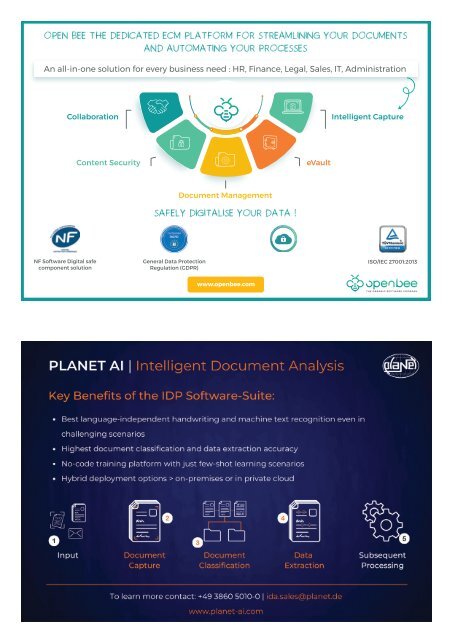DMLATEST
You also want an ePaper? Increase the reach of your titles
YUMPU automatically turns print PDFs into web optimized ePapers that Google loves.
STRATEGY: ECM Dm<br />
files and documents on a daily basis.<br />
5. Archive<br />
The ultimate goal of this component is to<br />
store inactive or historical content for<br />
long-term preservation and compliance<br />
purposes. This content is typically<br />
categorised, indexed, and encrypted for<br />
security. By offloading older content from<br />
active systems, the archive component<br />
optimises performance, reduces storage<br />
costs, and facilitates regulatory<br />
compliance within organisations.<br />
8 ECM BEST PRACTICES FOR 2024<br />
The following enterprise content<br />
management best practices will help your<br />
business successfully implement and<br />
utilise ECM systems. Remember to modify<br />
them according to your business's unique<br />
needs and challenges.<br />
1. AI-Driven Automation Integration<br />
ECM solutions can automate many<br />
business tasks. You can elevate this<br />
further by introducing AI into the mix.<br />
Different AI technologies, like machine<br />
learning and natural language processing<br />
(NLP), can automate repetitive tasks,<br />
extract insights from data at speed, and<br />
optimise content processing.<br />
As an example, AI can automate<br />
content creation. You can set AI to go<br />
through all your internal documents and<br />
direct it to get answers for FAQs or<br />
learning guides. With NLP, natural<br />
language search can be enabled, making<br />
content search more straightforward.<br />
AI-driven integration also reduces<br />
manual errors and frees up your team's<br />
time to work on high-value activities to<br />
keep your business ahead of the<br />
competition.<br />
2. Cloud-Based Solutions Implementation<br />
Moving to cloud-based solutions instead<br />
of sticking to traditional working methods<br />
can ease content search and<br />
management processes. These solutions<br />
can be easier to implement and manage<br />
than on-premise systems.<br />
Cloud-based solutions will decrease costs<br />
related to on-site storage, hardware,<br />
maintenance, constant security patch<br />
follow-ups, on-site updates and<br />
upgrades, and license management.<br />
Moreover, this enables your team (remote<br />
or in different geographical locations) to<br />
access the content whenever needed.<br />
Cloud solutions are easily scalable,<br />
allowing for seamless expansion<br />
whenever the content volume grows or<br />
business requirements change.<br />
3. Cybersecurity Measures for ECM<br />
Your ECM software will provide basic<br />
security measures like access controls,<br />
user authentication and data encryption.<br />
But what if a critical document gets out<br />
of the system that is not supposed to?<br />
What if an error causes a downtime?<br />
As security threats become more<br />
sophisticated, robust security measures<br />
are non-negotiable for your enterprise<br />
content management strategy. This is<br />
where ECM monitoring and management<br />
tools come into the picture. They can<br />
continually monitor user ECM activity,<br />
www.document-manager.com<br />
March/April 2024<br />
@DMMagAndAwards<br />
21

















